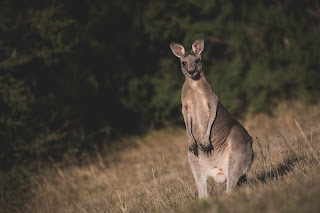Australia, often referred to as the "Land Down Under," is not only known for its stunning landscapes and pristine beaches but also for its incredibly diverse and unique wildlife. The continent's isolation from the rest of the world has given rise to a remarkable array of animals found nowhere else on Earth. In this article, we will explore the captivating world of Australian wildlife, with a focus on three iconic species: kangaroos, koalas, and the elusive platypus.
Kangaroos: Hopping Icons of the Outback
When one thinks of Australia, kangaroos are likely to be among the first creatures that come to mind. These marsupials are the very embodiment of the Australian outback and can be found throughout the continent. They belong to the family Macropodidae, which includes several species, each adapted to its unique environment.
One of the most recognizable kangaroo species is the Red Kangaroo (Macropus rufus), the largest marsupial on the planet. Males can grow up to 6 feet in length and weigh as much as 200 pounds. Their reddish-brown fur and powerful hind legs equipped with muscular tails for balance make them a true symbol of the Australian wilderness.
Kangaroos are known for their unique mode of locomotion – hopping. Their incredibly strong hind legs allow them to cover great distances with remarkable efficiency, conserving energy in the arid landscapes they call home. These herbivorous creatures primarily feed on grasses and plants, which have adapted to the harsh conditions of the Australian outback.
Despite their widespread presence, kangaroos face several challenges in the modern world, including habitat loss due to urbanization and vehicle collisions. Conservation efforts are essential to protect these iconic animals and maintain their vital role in Australia's ecosystems.
Koalas: Eucalyptus-Loving Tree Dwellers
In the treetops of Australia's eucalyptus forests resides another iconic marsupial, the koala (Phascolarctos cinereus). Often referred to as "koala bears" due to their teddy bear-like appearance, these marsupials are not bears at all. Koalas are marsupials, meaning they carry and nurse their young in a pouch.
Koalas are highly specialized to their diet of eucalyptus leaves, which are low in nutrients and high in toxins. Their digestive system has evolved to detoxify these leaves, allowing them to thrive on this unique diet. Koalas spend most of their lives in the trees, with their large, sharp claws and opposable thumbs adapted for gripping branches and climbing.
One remarkable aspect of koalas is their sedentary lifestyle. They sleep for up to 18-20 hours a day, conserving energy due to the low energy content of their food. Their slow metabolism also plays a role in their lethargy. When awake, they feed on eucalyptus leaves and communicate through a variety of vocalizations.
Koalas have faced significant challenges, including habitat loss, disease, and climate change. Conservation efforts, such as the establishment of protected areas and the rescue and rehabilitation of injured koalas, are crucial for their survival. Efforts to conserve their habitat and protect eucalyptus forests are equally important to ensure the future of these endearing marsupials.
The Elusive Platypus: A Marvel of Evolution
While kangaroos and koalas are iconic symbols of Australia, the platypus (Ornithorhynchus anatinus) is a true enigma and one of the most unique creatures on the planet. Often referred to as the "duck-billed platypus," this monotreme defies conventional classification. Monotremes are a group of egg-laying mammals found only in Australia and New Guinea, and the platypus is one of just five species.
The platypus boasts a truly bizarre combination of features. It has a duck-like bill, webbed feet, and lays eggs, yet it has fur and nurses its young with milk. These adaptations are the result of millions of years of evolution in Australia's isolated ecosystems.
One of the most remarkable features of the platypus is its ability to sense electrical impulses generated by the movements of prey in the water. This electrolocation sense, along with its webbed feet and waterproof fur, makes it an incredibly efficient predator in aquatic environments. Platypuses primarily feed on aquatic invertebrates, such as insects, worms, and crustaceans.
The platypus is famously elusive, often only spotted briefly in the wild. They are primarily nocturnal and highly secretive. Conservation efforts are essential to protect their habitats from pollution, habitat destruction, and invasive species that threaten these extraordinary creatures.
Conservation Efforts and Challenges
Australia's unique and diverse wildlife, including kangaroos, koalas, and the platypus, faces numerous challenges in the modern world. Habitat loss, climate change, invasive species, pollution, and disease all pose significant threats to these iconic species.
Conservation efforts in Australia involve a combination of strategies, including the establishment of protected areas, wildlife rehabilitation programs, and public education. Many organizations work tirelessly to ensure the survival of these remarkable creatures, both in the wild and in captivity.
Additionally, global awareness and support are crucial in protecting Australia's wildlife. Ecotourism plays a role in generating revenue for conservation efforts while educating the public about the importance of preserving these unique ecosystems.
In conclusion, Australia's wildlife is a testament to the wonders of evolution and adaptation. Kangaroos, koalas, and the platypus are just a glimpse into the diverse and unique creatures that call this continent home. While they face significant challenges, there is hope through conservation efforts and public awareness that these iconic species will continue to thrive in the wild. Australia's wildlife is a global treasure that deserves our admiration and protection.






.jpg)


No comments:
Post a Comment